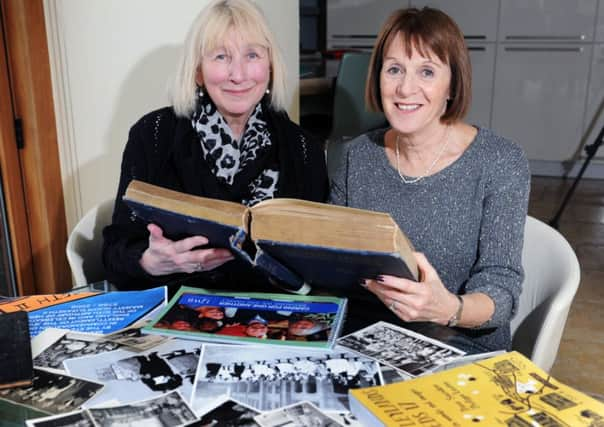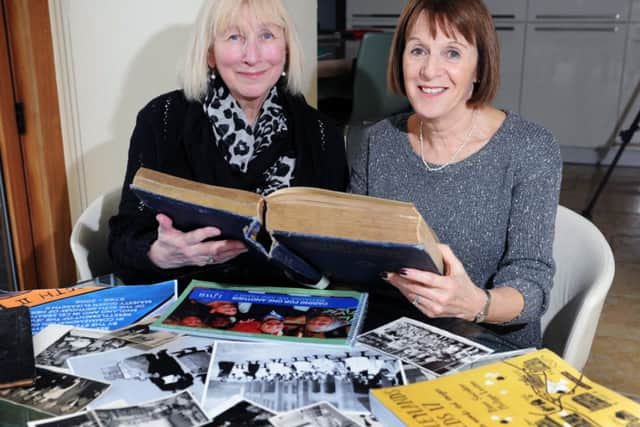Video: New book tells story of Jews in Leeds


LEEDS was a place of refuge for the poor and persecuted from around the globe long before it was officially designated a City of Sanctuary a few years ago.
Its Jewish community marked 150 years in the city in 2010 - dating that anniversary from the opening of the first dedicated synagogue in Belgrave Street in 1860.
Advertisement
Hide AdAdvertisement
Hide AdBut there was a small Jewish presence before that: the Chief Rabbi of England granted a shochet’s license (for the ritual slaughter of kosher meat) in 1833; Israel Benjamin of Vicar Lane was buried in Leeds Parish Church in 1739; and the first recorded Jewish wedding took place in June 1842, between Abigail Davis and James Pirani Cohen.


As the anti-Jewish pogroms in eastern Europe in the 19th century drove more of the population from their homes, some of that diaspora found its way to Leeds via ships bound for Hull or Grimsby, some so destitute that they completed the journey on foot.
The early settlers were a mixture of skilled craftsmen, including jewellers and tailors, pedlars and wool merchants. Often a man would travel alone, then save to bring his family to join him.
They threw themselves into the betterment of their children’s lives through education. Some families struggled economically for many years, surviving on tiny incomes earned in Jewish-run sweat shops.
Advertisement
Hide AdAdvertisement
Hide AdIn the 1920s, 62 per cent of Jewish bridegrooms worked in tailoring, and more enlightened employers allowed a groom to make his own suit for free.
But in the early years they lived with other immigrants in the dingy, cramped conditions of the Leylands - rows of small back-to-backs in an area close to Quarry Hill. Later generations of Jews from Poland, Lithuania, Romania and Germany joined the early incomers.
David Shiffer came to Leeds not long after his bar mitzvah in 1913 and contributed greatly to the community. Seventy members of the family he left behind in Goravarove, Poland, were wiped out by the Nazis.
At 29 Shiffer became president of the Leeds Jewish Welfare Co-Operative Society and New Central Vilna Synagogue. He was known within the faith as ‘Mr Leeds’ due to the volume of his voluntary work over 60 years.
Advertisement
Hide AdAdvertisement
Hide AdThrough hard work, drive and ambition, the Jewish population of Leeds grew, prospered (mostly), and over generations shifted northwards, first to Chapeltown then to Moortown and Alwoodley.
Where once a group of Jewish people would meet and pray in a room at someone’s house, they were later able to support several synagogues. In its heyday of the 1950s, the community in Leeds numbered 20,000.
Thanks in part to the disappearance of the textile industry, but also largely to education and movement to find jobs after university, many younger people have left the city, so today there are around 7,000. And, like the rest of the population, many Jewish families now have fewer children.
Across the years, the Leeds Jewish community has produced its outstanding public figures: from Fanny Waterman, founder of The Leeds International Piano Competition, to Messrs Marks and Spencer, singer Frankie Vaughn and actor Ronald Pickup to entrepreneurs and philanthropists like Montague Burton, the Ziff family and Leslie Silver.
Advertisement
Hide AdAdvertisement
Hide AdImportant though they are to the narrative of their own and the wider community, it was the story of the more ‘ordinary’ Jewish folk of the city that Diane Saunders and Philippa Lester in the book From The Leylands To Leeds 17 - Jewish Leeds in words and images.
“We didn’t set out to write a formal history of the community,” says Philippa, who got involved with the book having recently retired from her job as a civil servant in adult education.
She and Diane, who’s a financial adviser, met properly for the first time at a museum event for the 150th anniversary, to which hundreds of people contributed family memorabilia.
“Volunteers were wanted to put together a display, and it was right up my street,” says Diane. “I’ve always been into history, and Philippa has a history degree. We soon realised what a huge treasure trove of material there was about the community, between families and local archives.
Advertisement
Hide AdAdvertisement
Hide Ad“We found that we worked very well together. Neither of us could write without the other.”
What was originally envisaged as a much smaller book has turned into a 400-page coffee table volume, richly illustrated and and touching on the lives of many hundreds of people, living and dead.”
Some funding came from within the community, and volunteers donated thousands of hours to give testament to those who will survive not only in the book but in sound archive interviews.
Initially classified as ‘aliens’, over time Jewish immigrants became naturalised citizens and many sons of the community went on to fight in both world wars.
Advertisement
Hide AdAdvertisement
Hide AdWhen Britain declared war on German in 1914, the Leeds Jewish community was swept up in the wave of patriotic fervour and in the first 10 days 300 men enlisted - apart from those who had changed their names and joined up as non-Jews.
These were men who’d been born here. Accusations of draft-dodging were levelled at other apparently able-bodied Jewish men who did not join up. Most were not yet British nationals, and therefore ineligible.
A certain level of prejudice always existed, but during the war Yiddish speaking Jews were suspected by some of being German spies, and Jewish loyalty in general was questioned throughout the war, say Saunders and Lester.
Anti-semitic articles in the press helped to incite violence, and in 1917 Jewish people in the Leylands were attacked by a mob of 3,000.
Advertisement
Hide AdAdvertisement
Hide Ad“Far from being pro-German, the community had a proud record of supporting the war,” says Philippa. “Many Jewish women signed up as nurses and 3,250 Jewish men served in World War One.” One officer and 103 other men were killed, and many more injured. Many war honours were awarded to Jewish men.
During World War Two thousands of young Jewish men who had been born and educated in Leeds served their country.
The five ‘brave Barnett brothers’ and their two cousins joined up on the same day at Harewood Barracks on Woodhouse Lane.
“We never gave it a thought,” former paratrooper Philip Barnett said. “We wanted to fight the Nazis and also Oswald Moseley.” Two of the family did not return. Of the soldiers who did return, some later went off to fight for the establishment of the State of Israel.
Advertisement
Hide AdAdvertisement
Hide AdIn the book Saunders and Lester accept anti-semitism exists in Leeds but said they’d rather dwell on the positives.
From The Leylands To Leeds 17 by Diane Saunders and Philippa Lester costs £20 and can be ordered from Diane Saunders on 07946 533290 or Philippa Lester 07778 765654 Details also at www.makorjewishculture.org
There will be a day of live entertainment and an exhibition around the launch of the book, from 11am to 4pm on Sunday, November 30 at Etz Chaim Synagogue, 411 Harrogate Road, Leeds LS17 7BY. Info: 0113 268 0899.
Reactions to a new home...
Betsy Berlyn (reminiscing in 1979 about her arrival in Leeds in 1900): “My father came to Leeds first. He intended going to America and saved for my mother and five children to join him.
Advertisement
Hide AdAdvertisement
Hide Ad“We had a terrible journey: crossing the border illegally, we had to hide overnight in a field covered by a sheet, not making any noise.
“We were miserable when we first arrived in Leeds because we had left a lovely home in Russia and we only had one room downstairs and one room upstairs in Leeds. We cried for the first ten years.”
Philip Clavanski (arrived in 1900): “‘Mir zanen do’” - Yiddish meaning ‘We are here’. Those are the three best words I ever heard.”
Gilad Amit (arrived in Leeds from Israel in 2009): “I found a community that knows how to support its members in their good and bad times, a community that cherishes its heritage and tradition, and a community that is eager to preserve itself and look into the future.”